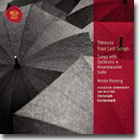Music |
Four Last Songs/ The Year of Living Dangerously
By
Published: Jun 17, 2014
Category:
Classical
Peter Weir’s “The Year of Living Dangerously,” released in 1982, stars a young, dazzlingly handsome Mel Gibson and an elegant, seductive Sigourney Weaver, and, playing a man, Linda Hunt. The setting is Indonesia, 1965. The dictatorship of President Sukarno is, finally, coming to an end. The capitol crackles with violence, danger is everywhere. And here is Gibson, a reporter who’s lucked into a great story, with an Indonesian midget dropping clues in his ear and a beautiful Brit accidentally telling him too much.
Because of death threats, the production had to move several times, finally settling in Australia. Mel Gibson was…well, Mel Gibson about it: “It wasn’t really that bad. We got a lot of death threats to be sure, but I just assumed that when there are so many, it must mean nothing is really going to happen. I mean, if they meant to kill us, why send a note?”
The love story is torrid. The crowd scenes are unnerving. And the random violence gives you a sense of what it’s like to live in a country where a man with a gun can change — or end — your life at whim. [ To rent or buy the video stream from Amazon, click here.]
People behave badly in moments of crisis. But not all people. There are heroes. And, in isolated moments, there is great beauty — surrounded by horror, someone affirms decency, love, art. In “The Year of Living Dangerously,” that’s what Linda Hunt does. Playing a soulful and doomed man, sitting alone near the end of the film, we hear her favorite music: Kiri Te Kanawa singing one of the “Four Last Songs” of Richard Strauss.
I was reduced to protoplasm by Kiri Te Kanawa. Her recording isn’t easily available. That’s okay. To hear Renee Fleming is to be transported to the same unlikely place — the gateway to heaven on earth. To buy the CD from Amazon, click here. For the MP3 download, click here.]
It is impossible to hear that music and watch Hunt’s performance — she won the Academy Award for Best Supporting Actress — and not feel pierced to the heart. For me, the next step was to hear all of those songs and learn what they meant. It’s quite the story, with a moral as old as time — you don’t have to be a great person to make great art.
Rchard Strauss was something of a prodigy. He succeeded early, and he liked success; it was said that “he wrote with one eye on the music and one on the box office.” His popularity made him suspect, and he was considered not quite first-rate. He wasn’t hurt. “I may not be a first-rate composer,” he said, “but I am a first-class second-rate composer.”
Strauss collaborated with the Nazis, though he drew the line at condemning his friends. He was not above fleecing his musicians at cards. A fellow conductor said of him, “We played cards every week for 40 years — and he was a pig.”
And yet. When he was 83, Strauss read “Im Abendrot” (At Sunset), by the noted poet Joseph Eichendorff:
Through trouble and joy we have
walked hand in hand;
we can rest from our wanderings
now, above the peaceful countryside.
The valleys fall away around us,
the sky is already darkening,
Only a pair of larks still rise
dreamily into the scented air.
Come here, and let them fly
For soon it will be time to sleep
and we must not lose our way
in this solitude.
O broad, contented peace!
So deep in the sunset glow,
How exhausted we are with our wandering
— can this then be death?
The composer’s wife, the singer Pauline de Ahna, was a soprano; Strauss quickly conceived of this poem as lyrics of a song for her. Later, Strauss read the poems of Herman Hesse. He found three that also spoke of approaching death. In just a few months, he had written four songs. He died a year later without ever hearing them performed.
These songs were not intended to be grouped together or even sung in the order in which they are usually recorded. No matter — from their first performance, listeners were struck by their intimacy and sincerity. Yes, sincerity, for here the master showman abandoned his slickness to make the case that death is nothing but a benign stroll into a final sunset.
Who wouldn’t like to believe that death is as Strauss saw it? And even if that’s only a fond hope, music this remarkably beautiful sounds like Exhibit A in making the case for a divine plan. These songs are serene, and yet they thrill. They give a soprano a chance to display the full range of her gifts, but they are beyond ego. In the midst of horror, they inspire.


